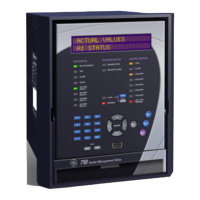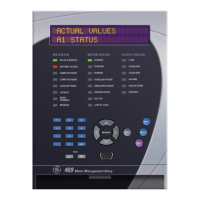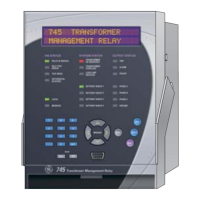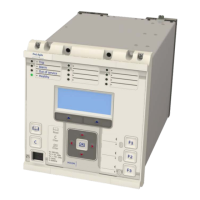GEK - 105560
27
In the first two situations we can go forward or backward throughout the entire list of settings by simply
pressing the
“+”
or the
“-”
button. On the nameplate, under the word “
SETTINGS
” a complete list can
be found.
If on the other hand,
ENTER
is pressed, the value of the setting will be seen blinking; if Enter is
pressed again the setting will be left as it was and on the screen the name of the current setting will
appear, for example
1-1
.
If instead of having pressed the last
ENTER
, the
“+”
or the
“-”
button had been pressed, the setting
would have been modified, either increasing or decreasing it by one step. This modification does not
take place until it has been confirmed with an
ENTER.
At that moment the setting is stored in the non-
volatile memory and protection with the new functioning parameters is started up.
In the
BEGINNING OPERATION
chapter of this book all of the operation units, settings, ranges,
stages and units are described.
Here is an example:
Let us suppose that in setting 1-3 (frequency slip) we have 20 mHz and we wish to change it to 70
mHz.
•
We begin with the Readout Sequence display, which gives us the line and bus activity, and go to
the Setting Sequence:
Display: - -
Press:
ENTER
(
F0)
appears on the display. Without releasing it press
“-”)
Display:
1-1
(the buttons can now be released)
•
We now go to the setting 1-3:
Press:
“+”
Display:
1-2
Press:
“+”
Display:
1-3
(we have achieved the desired setting)
•
Now we will modify it:
Press:
ENTER
Display:
20 -
blinking (these are the current 20 mHz)
Press:
“+”
(press 5 times since the pitch is 10)
Display: 70 - blinking (we now have the desires setting)
Press:
ENTER
(the change has been carried out)
Display:
1-3
In brief, the process is the same for any desired setting modification: select the code for the desired
setting modification, press
ENTER
, change it by pressing either
“+”
or
“-”
, and confirm the change
with
ENTER
.
If when the setting is being changed, the
“+”
or
“-”
button is held constantly, acceleration will occur,
speeding up the change in setting.
If the maximum allowed value for the setting appears on the display, pressing
“+”
will have no effect.
The same will happen if the minimum allowed value appears on the display and
“-”
is pressed.
NOTE
:
a change in settings causes all the units to restart; if there is an output activated, is will be
deactivated until the corresponding unit renews the activation.
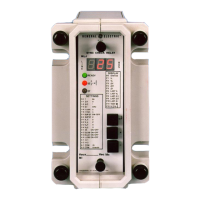
